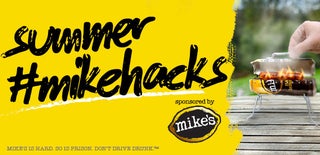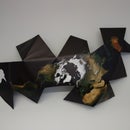Introduction: Portable Fresnel Solar Oven
Those sun rays traveled 150 million kilometers to get here, the least you can do is put them to good use. If you are looking to harness the power of the sun to cook your favorite casserole or crumble, then you need only to build a Fresnel Solar Oven. This is not the first solar oven featured on Instructables (see this or this), nor is it the first use of a Fresnel lens to cook (see here), but I wanted to try to make a rig for camping or for a picnic. The whole build folds nicely into a flat pack and is relatively robust; the oven-safe glass bowls and pot stack nicely as a separate piece to carry.
I was very pleased with the initial results: the pot reached 425°F in 10 minutes and the chicken rolls were beautifully done within half an hour. So put away that CO2 spewing BBQ once in a while and use the sun's freakish power to feed your family.
SAFETY WARNING:
HEAT: You are concentrating massive amounts of energy with these big lenses (YOU are the ant on the sidewalk in this case). You can easily burn yourself or curious children; see this example for illustration of power.
FIRE: You will easily set fires with anything combustible if you make the point of light small enough (example). Consider the consequence of leaning it on your house, or new car while to you go for lunch.
LIGHT: You WILL burn your corneas if you do not shield your eyes and the curious onlookers. Wear appropriate eye protection, keep the beam wide and shoo away kids. You will nor realize it while they are burning, your eyes get desensitized quickly, but can get damaged permenantly.
FOOD: Make sure any meat is cooked through before serving. There are many factors that will affect the speed of cooking: including clouds, angle of the sun, size of the lens size of your cut of meat etc. Use a meat thermometer and enjoy.
Step 1: What Is a Fresnel Lens and How Do I Get One?
Many of you are wondering what the heck is a Fresnel Lens. It basically has the same functionality as the lens of a magnifying glass, except that it cheats on the geometry to reduce the volume drastically. See the sketch above; in the lens I used, the ridges are barely perceptible except for texture: one side is smooth and the other feels grooved. You can buy these lenses from ebay, but most people get them from obsolete rear projection TV left out in the street. Each unit will be different but please check out the great video by Tool Using Animal too see the process of extracting the lens.
Please heed the safety warnings in previous step when playing with these lenses.
Step 2: ITEMS and TOOLS
For this project I used:
- One Fresnel Lens from a 52 inch rear projection TV.
- 16' long 1" by 2" of pine
- Seven small brass hinges
- Eight corner brackets to hold the frame together
- One small tube of silicone (any flexible adhesive will do)
- Two identical Pyrex or equivalent glass bowls about 8 inches in diameter
- One old black stove-top pot
- Various screws
Tools required:
- Drill, with a few small bits
- Screw drivers
- Utility knife with fresh blade
- Measuring tape
- Square (L-shaped ruler)
- Angle grinder (to take handle off the pot)
Step 3: Wooden Frames
The lens you have on hand will define the size of your frame. You want to make two identical frames that together fit perfectly within the confines of the lens. Measure twice, cut once. I messed up a few times with the pieces of the frame and orientation; if in doubt go back to the lens and put the pieces down on top of it. Use the corner brackets on the inside of the frames, fastened with screws.
Prime and paint your frames to protect them for years to come.
Step 4: Legs, Hinges and Closure
Ideally, you will want to test the focal length of your lens (each will be slightly different): measure the height of lens off the ground required to obtain a beam around 3 inches wide. You will need a friend to this and its best to wait till midday. There is no point of creating a single point of light because you want to cook your food throughout, not burn a point and leave the remainder raw. Unfortunately the length of the legs are restricted to the size of the frame to fold back into a tight package. In my case the rear legs were slightly too short for the optimal focal distance, so I am boosting them up 4 inches with whatever I have on hand in the field (firewood, food cans).
Again, check the geometry of the frame with respect to the lens prior to screwing in the hinges (I screwed up here again). I used the screws that came with the hinges except for those that went into the ends of the legs where I used higher gauge and longer screws. Make sure to pre-drill the screw holes, particularly for the wider screws into the legs. The rear legs are longer and should be installed on the outer back of the frames, this way they can be pointed outward and oppose lateral force to stay standing. The third leg was installed at an angle to have a slight lateral force towards the rear legs.
I wanted the frame to stay closed on its own, so in decided to use some Nd-magnets I had on hand from a previous project. I drilled small holes for the magnets, filled them with silicone and hammered them in with a bolt. On the opposite side of the frame I installed small screws. The result was underwhelming... but it keeps together very well with friction from the four hinges and tacky paint.
Step 5: Cutting the Lens
I know what you're thinking: "You cant cut the lens... you are breaking it!" It turns out that the lens does't mind and neither do the sun rays. I am losing some of the power due to the edge of the frame at the center, but not much more than the rest of the frame along the edges. It is a sacrifice for portability.
Put the lens down on some wood with a straight piece of steel clamped into place. Use a sharp utility knife to to repeatedly score the lens. After 5 passes you will likely be able to pick up and bend it backwards and it should cleanly snap it two.
Step 6: Glue the Lens Onto the Frame
I just used a bead of silicone on the frame to attach the lenses.
Groovy side up or down? It actually doesn't make much of a difference light-ray wise, because you are not trying to concentrate to a point of light. I found that the groovy side was very prone to scratches so I decided using it on the inside to protect it.
Step 7: Cooking Vessels
I bought a set of oven-safe glass cookware my local hardware store (Canadian Tire). The pot was a spare from my camping set. I used an angle grinder to remove the handle from the pot (along with a hammer and bolt to get the pins out).
The two glass bowls act as a greenhouse to keep the hot air inside, much like your car on a sunny day. The pot is black and non-reflective on the inside, it is relatively massive and will keep some heat if sun hides behind clouds for minute or two. I used a towel from my hockey back to insulate the base of the cooking unit and limit the heat loss in this direction.
Step 8: Final Comments
I haven't experimented much yet, but I would not try anything that is very temperature sensitive (cake, souffle) or requires several hours to cook (roast beef, whole chicken). Even though the pot reached 425°F and stabilized there, I doubt the air reached that temperature. I recommend using a meat thermometer to make sure your food is well cooked (also check all the warnings on the first step: heat, fire, eyes)
Obviously results are going to vary with:
- Size and quality of the lens; mine was 52 inches diagonal.
- Cloudiness and angle of sun in the sky; noon in summer is best.
- The mass of what you are tying to cook; the lighter the faster.
I was pleasantly surprised by the result and I have been looking at the forecast everyday since I built this thing to see which days are going to be sunny. Please leave a comment below or to let me know if you have attempted this and share your stories.

Participated in the
Summer #mikehacks Contest

Participated in the
Epilog Challenge VI

Participated in the
Great Outdoors Contest













